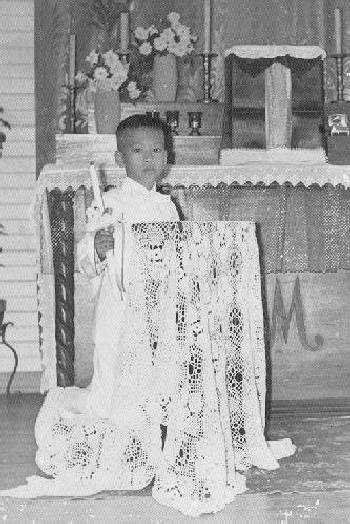
Philippines First Communion Suits

Figure 1.-- We do not yet know a great deal about First Communion in the Philippines. We do not know, for example, what proportion of Filipino children do First Communion. We note many children wearing European styles First Communion outfits, but the Philippines tropical climate is a factor. All we know about the boy here is hat he was from Roxas City.
|
The first Europeans to reach the Philippines was the expedition led by Ferdinand Magellan (1521).
A series of Spanish expeditions followed. The ecploers named the Islands the Filipinas, in honor of Philip II, Spain's agressively Catholic monarch. The Spanish proceeded to colonize and Christiasnize most of the various islands. The Muslims inhabitants in the south, especiall Mindanao resisted Christianity. The Spanish faced insurgent efforts throughout the colonial period, but Christianity was widely accepted. We do not yet know a great deal about First Communion in the Philippines. We do not know, for example, what proportion of Filipino children do First Communion. We note many children wearing European styles First Communion outfits, but the Philippines tropical climate is a factor.
HBC

Navigate the Historic Boys' First Communion pages:
[Return to the Main National First Communion page]
[Return to the Main Philippines page]
[Return to the Main First Communion page]
[Renewals]
[America]
[France]
[Spain]
[Switzerland]
Navigate the Historic Boys' Clothing Web Site:
[Introduction]
[Activities]
[Biographies]
[Chronology]
[Clothing styles]
[Countries]
[Bibliographies]
[Contributions]
[FAQs]
[Glossaries]
[Satellite sites]
[Tools]
[Boys' Clothing Home]
Navigate the Historic Boys' Clothing Web chronological pages:
[The 1900s]
[The 1910s]
[The 1920s]
[The 1930s]
[The 1940s]
[The 1950s]
[The 1960s]
[The 1970s]
Navigate the Historic Boys' Clothing Web style pages:
[Short pants suits]
[Blazers]
[Jackets]
[Kilts]
[Sailor suits]
[Sailor hats]
[Ring bearer/page costumes]
[Shortalls]
Created: May 5, 2000
Last edited: 8:59 PM 12/15/2006



